Tim Davies: June 2008 Archives
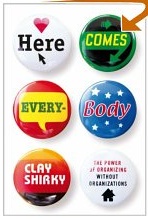 When we encouraged Youth Workers in Rotherham to explore MySpace and Bebo a few weeks back - many put the names of young people they knew into the search engines and found they were quickly browsing public exchanges of messages on profile walls talking about nights out, social goings on and the latest news from small friendship groups.
When we encouraged Youth Workers in Rotherham to explore MySpace and Bebo a few weeks back - many put the names of young people they knew into the search engines and found they were quickly browsing public exchanges of messages on profile walls talking about nights out, social goings on and the latest news from small friendship groups. In 'Here Comes Everybody: the power of organising without organisations' Clay Shirky explores exactly this phenomena and reflects:
...it's easy to deride this sort of thing as self-absorbed publishing - why would anyone put such drivel out in public?
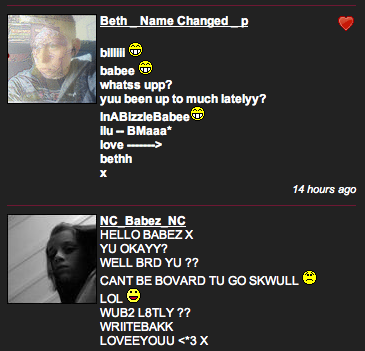 And, in the case of professionals concerned with young people's safety, it's easy to react to this sort of sharing as odd, weird and worrying behaviour by young people. But Clay encourages us to at least be critical as we look to understand what is going on.
And, in the case of professionals concerned with young people's safety, it's easy to react to this sort of sharing as odd, weird and worrying behaviour by young people. But Clay encourages us to at least be critical as we look to understand what is going on. It's simple. They're not talking to you.
We misread this seemingly inane posts because we're so unused to seeing written material in public that isn't intended for us. They people posting messages to one another in small groups are doing a different kind of communicating than people posting messages for hundreds of thousands of people to read. More is different, but less is different too. An audience isn't just a big community; it can be more anonymous, with many fewer ties amongst its users. A community isn't just a small audience either; it has a social density that audiences lack. The bloggers and social network users operating in small groups are part of a community, and they are enjoying something analogous to the privacy of the mall. On any given day you could go o the food court in a mall and find a group of teenagers hanging out and talking to one another. They are in public, and you could certainly site at the next table over and listen in on them if you wanted to. And what would they be saying to one another? They'd be saying "I can't believe I missed you last night!!! Trac talked to you and said you were TRASHED off your ASS!" They'd be doing something similar to what they are doing on LiveJournal or Xanga, in other words, if you were listing in on their conversation, rather than reading their post, it would be clear that you were the weird one.
So, what are Youth Workers to do? Well - the difference between the mall and the MySpace profile, is that in the Mall (ok, let's switch to shopping centre and Anglicise this a bit) - in the shopping centre, you have more of a chance of noticing that someone is listening in on your conversation and adapting behaviour accordingly. By default, social network sites don't afford their users the ability to sense or know who is looking at what they share in online conversations.
Helping young people to identify the possible invisible audience for their conversations online... from parents or teachers, other peers, through to anonymous adults - and to change their privacy settings or behaviors to take account of that could form a key part of any youth work sessions with young people that explore social networking.
If you're ready to go beyond the simple one page introduction to MySpace I posted last week - then you may want to check out the wide range of Social Network Site tutorial videos on the Video Jug website.
You'll find a whole range of videos that step you through creating a profile, sharing media and using the safety features. The videos are fairly long - but most give a good overview of their topic - like the example below on 'Staying safe on FaceBook'.
How To Stay Safe On Facebook
If these can be accessed from your network (it's possible that local authorities may be blocking Video Jug) then perhaps a selection could work as part of staff training or a staff information-kit on Social Network Sites...
You can watch a short overview of the research below, and you can see an interview with researcher Christine Greenhow on the University of Minnesota website.
From the video:
...as a result of maintaining their own MySpace profiles, students in Minneapolis have learned advanced technological skills, such as how to create blogs and Web pages and upload music, movies and pictures...For youth work, the same can hold true. There is a need to help young people find positive uses of social network sites, and the wider social media side of the internet, that are to their benefit.
...much like how a parent or teacher helps their child learn how to drive a car, which can be dangerous …in today’s world, parents and teachers also need to help their students learn how to use potentially dangerous social networking sites safely and to their advantage.
One of the things we need to work out as part of our action research is how to present that sort of information. So - as I've explored the one page guide format in the past - I've put together a
one page introduction to MySpace.

You can download the guide here and it should:
- Give an overview of what the MySpace social network site is, and what it can do;
- Take you step-by-step through creating a MySpace profile, exploring the site, looking at privacy settings, and, if you need to, deleting your account afterwards.
- Give you some key facts about MySpace.
I'd love to get your feedback about whether this format of guide works. Do you think this would be useful in your youth service or project? Who would you give this guide to? Is there any information you would add or adapt? Or anything you would take away?
Do drop in your comments using the comment feature on this site, or head over the UK Youth Online discussion space to share your reflections (I'll set up a discussion in the forums there...)
What should workers do about Social Network Site profiles? How should they announce their identity as a youth worker? What sort of processes should they use for recording information?
One of the suggestions being explored is that policy and guidance for engaging with Social Network Sites should be based upon those for detached youth work. See what you think and join the discussion over here.
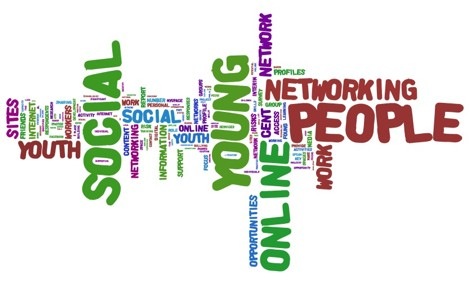
DK over at Mediasnacker's has kindly run the Youth Work and Social Networking report through Wordle, a tool which visualise the words commonly used in the document.
It might help give a bit of a sense of what the report is all about. Then again, it might not - for that you might need to read at least the executive summary. But it does look kind of cool.
Perhaps Wordle could be an interesting tool for helping young people analyse texts?
Last Friday I took the long train journey up to Gateshead to meet with Joanne Jopling from the Gateshead Young Women's Outreach Project to talk about how the project could make wider use of social networking - particularly to provide online discussions spaces, and online advice and support for young women across the area. In the end, our conversations ranged right across the Youth Work and Social Networking territory - and I was so inspired by Joanne's engagement with online tools for youth work, and her clear sense of the need for youth work to get online and support young people where they are at - that I wrong up the case study below on the long train journey home. There's lots in here
Case Study: Youth Work Online with the Gateshead Young Womens Outreach Project
 Joanne at the Gateshead Young Women's Outreach Project started using MSN messenger to communicate with young people a couple of years ago. After spending over two months working with one issolated young woman, and rarely being able to make eye contact or get into conversations with her, one evening Joanne used her home computer to sign on to the MSN instant messenger program and to exchange instant messages with the young woman.
Joanne at the Gateshead Young Women's Outreach Project started using MSN messenger to communicate with young people a couple of years ago. After spending over two months working with one issolated young woman, and rarely being able to make eye contact or get into conversations with her, one evening Joanne used her home computer to sign on to the MSN instant messenger program and to exchange instant messages with the young woman.
Over the course of an evening's conversation, typing back and forward on MSN, they were able to exchange messages about the weather, to talk about particular challenging issues the young woman was facing, to chat about the young women's project and to have a fun conversation. When the young woman came into a group project session the next week she was far more engaged in activities, and Joanne could build upon the relationship struck up through instant messaging.
Now the Gateshead Young Women's Outreach Project makes use of a wide variety of tools - with young people able to contact staff by text message, instant messenger, and most recently, through a group on Facebook. The Facebook group is only open to young women who have been in touch with the project, and provides a space for discussion.
 Joanne also has a personal Facebook profile, and allows young people she has worked with to add her as a friend. Having a profile lets her see 'status updates' posted by the young women she works with - so she can identify issues of challenges they may be facing, and, where appropriate, can get in touch. Being on Facebook has also helped Joanne to identify and address occasions when young people have shared inappropriate pictures or information. "Recently I noticed one girl had a really unsuitable profile picture. I wouldn't deal with that via a message online - but I knew she was coming into the centre on Monday, so I had a quiet word with her about it - and in fact it led to a group discussion about profile pictures and what they say about the person. If the young woman hadn't come into the project on Monday then I may have phoned her up, or even gone round to talk about it."
Joanne also has a personal Facebook profile, and allows young people she has worked with to add her as a friend. Having a profile lets her see 'status updates' posted by the young women she works with - so she can identify issues of challenges they may be facing, and, where appropriate, can get in touch. Being on Facebook has also helped Joanne to identify and address occasions when young people have shared inappropriate pictures or information. "Recently I noticed one girl had a really unsuitable profile picture. I wouldn't deal with that via a message online - but I knew she was coming into the centre on Monday, so I had a quiet word with her about it - and in fact it led to a group discussion about profile pictures and what they say about the person. If the young woman hadn't come into the project on Monday then I may have phoned her up, or even gone round to talk about it."
"Youth workers should be in these spaces, working with young people. It's just like detached work - but online. We need to be picking up issues, joining conversations and helping guide them or providing positive input. We need to help young people work out where the boundaries are online".
Joanne acknowledged that some workers may find working with young people online rather than face to face to be challenging - and if performance measures are based on 'face to face contacts' workers may find they can't easily make the time for online interaction with young people. Crucially, however, in Joanne's work, online interaction complements in-person work, providing a new way to communicate with issolated young people, and offering a new entry point to youth services for young people who may not otherwise be in contact with a youth worker or project.
Is Joanne worried that talking to young people online, rather than face to face, could put her at risk from allegations of improper conduct? Not really - as online there is a clear record of the conversations - they can all be saved. It's no more 'risky' for the youth worker, or could even be less 'risky' than detached work or one-to-one work that takes place face to face.
Joanne's experiences do highlight a challenge in maintaining a professional/private divide, and raise issues about working hours. Young people may want to chat on MSN early morning, or late in the evening, or may be in touch by text message 'out of hours', but Joanne feels that youth work is a profession where you have to take your values home with you - and if that means occasionally responding to a young person in need when they need you to - that's is what should be done. That doesn't mean always responding or being always on duty - and Joanne emphasises the importance of being honest with young people.
The Gateshead Young Women's Outreach Project are keen to develop their engagement with new technology - and exploring replacing their own website with their own Social Network build on top of Ning.com. All the professionals young people want to contact could have profiles on the site - and young people could join in discussion forums. In Joanne's experience of running discussion forums in the past, pre-moderation isn't needed - and if any issues arise then (abusive language / aggression / sharing personal details against the forum guidelines) then these can be addressed by a discussion in the forum which helps everyone learn for the future. "It's not about control - it's about supporting young people".
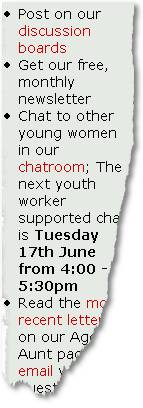 Joanne is also keen to explore scheduled live chats with youth workers and other professionals - both so that young people can get information, advice and guidance - and for helping young people's informal learning and accreditation. "If a young person takes part in three hours of discussion online about health - you can save the chat and you've got evidence of their contribution - and they can get one unit further forward towards an accredited outcome or award."
Joanne is also keen to explore scheduled live chats with youth workers and other professionals - both so that young people can get information, advice and guidance - and for helping young people's informal learning and accreditation. "If a young person takes part in three hours of discussion online about health - you can save the chat and you've got evidence of their contribution - and they can get one unit further forward towards an accredited outcome or award."
Joanne would like to see Youth Workers just getting stuck in and trying out new online tools - getting to know them and really thinking about how they can support positive and professional work with young people.
--------
If you've got your own case study of great online youth work to share, get in touch - or head over to the discussion space on UK Youth Online to join the discussion about youth work for a digital age.
We thought we had done well for today's Youth Work and Social Networking training session in Rotherham. As less than 30% of youth workers commonly have access to social networking sites in their workplaces many simply haven't ever spent any time looking at MySpace, Facebook or other social networking sites. So we had arranged to have the filters on the computers in the youth centre where we were meeting scaled back for key sites. We had asked plenty in advance - and listed all the sites we wanted to access - but all wasn't plain sailing.
Here's a quick round up of some of today's learning:
1) If the internet access provided to your youth centre is filtered you can probably ask for changes to be made to the filters, or for the filters to be scaled back for specific sessions.
If the internet provision is outsourced then there may be a small charge related to changes made to the filtering systems (as was the case in Rotherham). However, it is worth finding out whether:
- Your internet provided can set up scheduled differences in the filters (for example, so that Social Network Sites are available on a particular club night between 7pm and 9pm, when you have agreed that you will always closely supervise internet access).
- You can gain access to a 'bypass password' which will let a trusted member of staff unlock access to a particular site for a period of time (without needing to phone up technical support).
2) If you do want filters temporarily removed - make sure you let the internet provider know plenty in advance - and make sure check that it's worked before the session you need access for
We needed to access sites in the afternoon. Luckily we checked at 10.30am if the filters had been lifted. Because we spent quite a bit of the next hour on the phone to tech support trying to get the changes right. (But that was mainly because we hadn't yet learnt point 3).
3) Social network sites often use more than one website address to deliver their content: and you need to make sure all the different addresses are unblocked.
This point is a bit technical - so I'll use an example. To access the Facebook social network you type 'http://www.facebook.com into a web browser. So you might think that it was just www.facebook.com that you needed your IT provider to allow access to.
However, because Facebook is so massive, some of the images and layout files that make a facebook page appear are provided by a 'Content Delivery Network' - another set of computers with their own website address (in this case http://fbcdn.net)
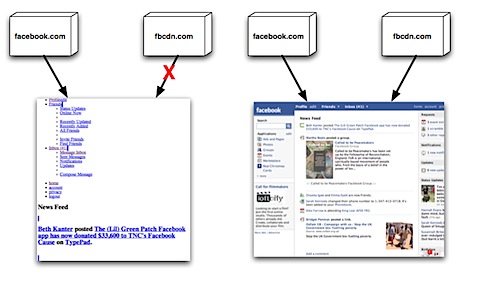
If you don't get the blocks removed for this site as well you will end up unable to see the right layout for a site, or with all the images and videos failing to load.
So - if you're asking for site to be unblocked here are the details you will need (as of 10th June 2008)
- For Facebook you will need to unblock: facebook.com and fbcdn.net
- For MySpace you will need to unblock: myspace.com, uk.myspace.com, myspacecdn.com and myspacetv.com
- For Bebo you will need to unblock just bebo.com
- For TakingItGlobal you will need to unblock takingitglobal.org and tigblog.org
- For Ning you will need to unblock just ning.com unless the social network you are using has it's own domain name which is also blocked - in which case include that in your request too.
4) If your centre has computers which are independent of the local authority network, or if you need internet access on the go, you may be able to us a '3G Modem' to get unfiltered internet access.
3G Modems can plug into a computer and access the internet at broadband speeds over the mobile phone network (where the signal is good enough). 3G Modems are available on contracts and on Pay as You Go models from around £10 per month / per gigabyte of data you use (1Gb of data is enough for a couple of weeks regular web browsing use an a couple of hours of low quality online video for example). 
As they don't need to be connected to a computer all the time - they can be plugged in when a supervised internet access session is taking place - but as they connect directly to the internet they bypass any filters that have been set up.
This does mean that the filtering provided by local authorities to prevent access to illegal sites, pornography and other age-inappropriate and unsuitable material is also unavailable - but where internet access is being supervised this may not be a problem.
5) In in doubt - ask
The internet provider should be there to provide you with internet access. If you need access to a website for your work with young people - ask for it. Until the organisations providing internet access to youth centers start finding they're getting daily requests for sites to be made accessible, they're unlikely to be developing a better solution that allows youth workers to engage with, and support young people in using, online social networks.
---
It would be great to hear from others who have had experience dealing with the filters on their internet access. What have you discovered?
If there is enough interest then we'll try and put together the learning from our experience in Rotherham, plus other's experiences, into a quick How To sheet...
 Social Capital is a concept that will be familiar to many youth and community workers. Online Social Networks can be seen as tools that support individuals to develop both their bridging and bonding social capital resources. Using social networks to share media, communicate, collaborate and articulate relationships can intensify young people's interactions and depth of bonding with friends. Using a social network to keep in touch with aquaintences, or to get introduced to friends-of-a-friend can help an individual develop a useful 'stock' of bridging social captital.
Social Capital is a concept that will be familiar to many youth and community workers. Online Social Networks can be seen as tools that support individuals to develop both their bridging and bonding social capital resources. Using social networks to share media, communicate, collaborate and articulate relationships can intensify young people's interactions and depth of bonding with friends. Using a social network to keep in touch with aquaintences, or to get introduced to friends-of-a-friend can help an individual develop a useful 'stock' of bridging social captital.
However, as Nick Booth notes in his write up from the Big Debate on Digital Utopia in Birmingham yesterday - individuals existing social connections and social capital also influence how likely they are to engage with the social web.
We can’t bridge the digital divide simply by providing internet access. Stepping across that divide comes when people use the internet to strengthen their social network and enrich their stock of social capital.
...Earlier today Jo Geary clearly made the point that the digital divide is not simply about acess to technology. Loads of people have access to the internet, but choose to use it rarely or not at all.
...To my mind the digital divide is much like the economic divide between work and worklessness. If someone has been out of work for a long time it may well be a question of getting them into the flow of new networks, connections that can give them the confidence and the information to find and keep a job.
To step higher up the work chain is again often connected to connections. Strengthening your network to gain greater access to ideas, intelligence, support and encouragement can make the critical difference between being led and becoming a leader. To do this people will often benefit from a mentor or a sponsor, someone in their existing network who’ll get them across the bossed and boss divide.
One of the challenges for youth work is to help mentor and sponsor young people in finding positive networks that they can be part of - and to assist excluded young people in making positive use of ever-more-important networking tools in order to ensure they're not the wrong side of a growing social-networking, and social capital, divide.
Josie Fraser has just published a fantastic report and resource about using online social networking with young people in education contexts.
You can read the full report online, or download an overview PDF.
Particularly useful is the Social Network Site comparison chart - which looks in depth at the major social networks, their features and their policies on users age, acceptable use and shared content.

